The Molalla Log House, possibly the state’s oldest structure, reveals secrets that may rewrite the first chapter of Oregon’s pioneer history. Researchers think Russians were first to build in Oregon.
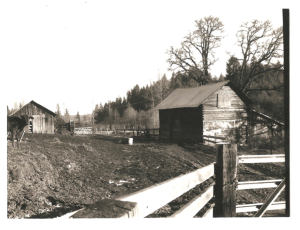
MOLALLA, OREGON – The historic Fox Granary in rural Clackamas County was no secret to local history buffs— the county declared the expertly crafted log building a historic landmark in 1991. But no one realized just HOW historic it might be and today that structure, identified as the Molalla Log House, is revealing some fascinating secrets.
For six years, with the support of the Kinsman Foundation and Restore Oregon, architectural historian Pam Hayden and pioneer construction/restoration expert Gregg Olson have worked to unravel the mysteries of the Molalla Log House. Clues about its origins have led them to a startling conclusion, which, if confirmed, would rewrite the first chapter of Oregon’s Settlement.
Local records note that the Molalla Log House was moved in the 1890s to the location in which Hayden and Olson found it in a state of partial collapse. The building was put to various uses over time, including a house, animal shelter, machine shed and hay storage, until it was dismantled in 2008 to save it from further deterioration. Documented and moved safely to a local warehouse, the logs have been carefully studied to understand the builders and their techniques, and to assess rehabilitation needs.
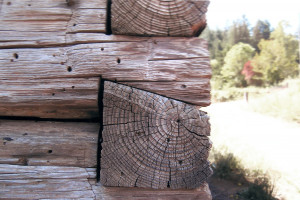
Molalla Log House is a small, primitive
building; it measures 18′ X 25′ and has
seventeen log courses, without a roof. The
unique construction technique was immediately
apparent to Gregg Olson as being expertly
crafted in a cultural tradition different from
those used by Oregon Trail pioneers.
Unraveling the Mysteries Around Who Built it
Unlike typical pioneer construction where chinking was used to fill in gaps in log cabin walls, these logs were hewn to stack so tightly together that there was no need to fill the spaces between them to keep out the weather.
The half dovetail corner notching is similar to a finely crafted cabinet. The craftsmanship displays expertise in building with Douglas fir, a soft wood unlike the hardwood used by pioneers from the east and mid-west. The roof design is also foreign to American builders and is believed to have been thatched. The house was left unfinished— windows were planned for with cuts marked in the logs, but never opened. There was one door.
Possibly Pre-dates Lewis and Clark
What Olson and Hayden thought might be an 1850s-period log building turned out to be much older. The Molalla Log House may have been built even before 1805-06, when American explorers Lewis and Clark built Fort Clatsop near the mouth of the Columbia River.
Although the date the house was constructed is not documented or confirmed, dating techniques and historic research indicate the log house may have been built between 1795 and 1810.
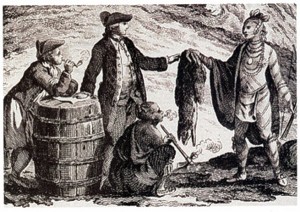
During this period, Russian maritime fur hunters and traders with the motivation, ability, and cultural tradition of building with logs similar to the Molalla Log House were working out of Alaska. Could the Molalla Log House have been built by persons from European Russia, familiar with the ancient building traditions known in the geography of the Baltic Sea?
It’s open to debate, but the research team believes the house was built by Russian peasant farmers in conjunction with Russia’s fur trade in Alaska. The Russian Crown intended to use the Russian fur trade in Alaska to aid in the colonization of the northwest coast of America north of the 45th parallel, even as late as 1819. Fur hunters and traders in Alaska were starving as efforts to feed them through farming failed. The fertile Willamette Valley in the foothills of the Cascades would have provided the needed landscape to establish farms to grow wheat and to hunt land based furs. Peasant farmers and craftsmen were sent by Russia’s Catherine the Great in the 1790s to Alaska to help build agricultural communities.
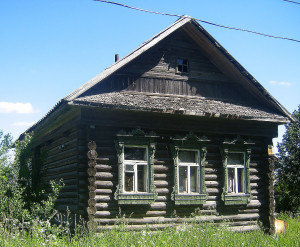
The Kalapuya Indians, native inhabitants occupying the Molalla area during this period, were not known for their hostilities and may have been tolerant of a small agricultural settlement.
Although much of the history of Russian America was either a secret, never documented, or lost in the 1790s, we do know that they had the knowledge, the wherewithal, and the motivation to briefly occupy land in Willamette Valley between 1795 and 1810.
At the request of project advisors, Olson and Hayden published a treatise in 2012 documenting their knowledge of the building, entitled: Molalla Log House-Fox Granary, Theory of the Origins of a Potential Surviving Relic of a 1790s Russian Occupation of the Oregon Country.
Continued Investigation is Needed
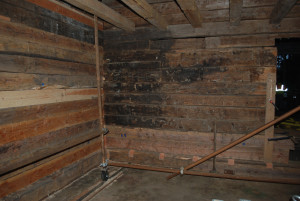
Subsequent research and analysis of the building continues. Hayden and Olson are reaching out to the greater community in hopes to increase their understanding about the building’s origins. Although a careful theory has been developed, the research team are asking others to come forth who may have any additional information that might help solve the mystery of the Molalla Log House.
The definitive questions about the Molalla Log House remain:
- Why was this hand hewn log house built on the northeastern edge of the Willamette Valley in the late 1700s or early 1800s?
- Who were the builders and what was their motivation to construct a log house for a brief occupation in the Molalla area c.1800?
The building was moved in 1892 and the original site remains unknown. Historic research has led the research team to speculate that house was originally built two miles north of where it was found, near Rock Creek and four miles west of the Molalla River in Clackamas County. Preliminary archeological investigation in 2013 was not successful in linking the Molalla Log House to the area of speculation. Further investigation may reveal additional information in the future.
Searching for a New Site for the Log House
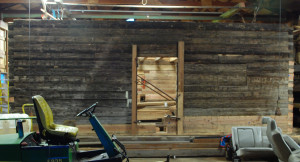
The house is in the final stages of rehabilitation. It is being fitted and stacked in a warehouse in preparation for reconstruction once a suitable steward and site is found for the building. Regardless of its potential intriguing history, the building is important for preservation and interpretation because of its age, design and craftsmanship. It exhibits an ancient efficient and foreign building tradition, unknown previously in Oregon.
The rehabilitation work will be complete by April 2015. A secure site is needed where the log building will be protected and under cover. An entity also is needed to take on the long-term stewardship for public education and interpretation of this extraordinary Oregon historic treasure.
Project Sponsors
The Kinsman Foundation has funded the dismantling and rehabilitation of the log house since 2008. The National Trust for Historic Preservation and the Clackamas County Cultural Coalition funded a preliminary Archeological Survey. The Molalla Area Historical Society and Restore Oregon have provided support and acted as fiscal sponsors for the project. Project Advisors have supported the project through their expertise in the fields of architectural history, archeology, history, dendrochronology and historic preservation. Dozens of additional volunteers have donated their time and expertise. Doug Babb, CFM, assisted with public outreach.
Learn More
The educational program to be presented by this research team on February 18th at Portland’s Architectural Heritage Center will feature slides and discussion, sharing information about what is known to date about this mysterious building, which is believed to have been built during a time undocumented in Oregon history.
Project Team
Gregg Olson and Pam Hayden have worked as at team at all junctures to unravel the building’s unique origins and rehabilitate the physical structure.
Gregg’s business is Historic Building Repair. He is an expert in log buildings, having studied both in England and Oregon. Along with other aspects of Gregg’s work in historic preservation, he has restored several of Oregon’s oldest log buildings.
Pam Hayden is a retired specialist in historic preservation and has worked to identify, preserve and protect historic resources in Clackamas County for over 30 years. She is this project’s coordinator for grants and has been responsible for conducting the historic research.


I don’t know all of the facts you have gleaned from the Molalla log house and its construction, so I may be talking way out of turn here, but it struck me as odd, to say the least, when I learned you theorized this dwelling was constructed by Russians. The Russians were known to have gone as far South as the California coast in their quest for sea otter furs, but did they venture far from the sea? I read of one tale that someone had found gold inland in Alaska during the Russian occupancy there. The news was greeted with a resounding so what? Meaning they felt their mission was to exploit the fur trade.
It should also be noted: 1) The French and the Métis were certainly in the area at an early date. 2) Construction techniques that were already in use in the old states were not only hardwoods, but also pines not unlike the Douglas fir found here in the Northwest of the same hardness and work ability. 3) No doubt some builders of log houses, no matter where they may have been located, were built with some better skilled hands than others—in every age.
Non-the-less, I find the story of the Molalla Log house an intriguing one.
As an interesting side note, if you haven’t already done so, I suggest you watch the eighth episode of season one of Roy Underhill’s the Woodwright’s Shop. A teaser can be found here: https://www.youtube.com/watch?v=sc9CaA8tS3M&list=PLpsX1mYtV7UH2WrRn5mnGLvZ5HI0RipRU&index=8
The whole episode can be bought from PBS or Popular Woodworking Magazine—or you could borrow my copy.
Additionally, I’d like to inspect the building if I may. Not that I am an expert, just an enthusiast. How would I go about doing that?
All the best.
John Rawlings,
Thanks for your post, comments and youtube web site.
I would be happy to show you the building before it is dismantled in May. If you give me your email address we can converse about where to meet and when.
I can also send you an online copy of the Treatise Gregg and I wrote in 2012, at the request of our fiscal sponsors and advisors, which describes in detail historic research and our findings which have led to the Russian American theory.
Best,
Pam
Hello Pam,
This in response to an email you sent me–not the letter above. I was somehow directed here when I replied. Any way as you can see my email is rawlingsrod@yahoo.com my phone number is 206-919-7535, even though I live in Wilsonville. I’d love to see the building before you dismantle it again in May and I would like to read the online treatise as well. Send me a PFD if possible.
Thank you very much.
Hello Pam’
Got the Treatise thank you. Look forward to meeting you and surveying the MLH on any of the dates you set forth–but the Tuesday and Thursday dates might be best for me. I’m in Wilsonville, so I can’t be to far to the site. my email is rawlingsrod@yahoo.com or you can call me on my cell @ 206-919-7535. The only problem with that is I usually don’t answer up on numbers that aren’t already in my phone, but if you leave a message and a number to reach you I with call you back. Hope to hear from you soon.
JR
I haven’t the time to read all the details about this so I might be repeating something, but one comment mentioned on television about it struck me as a bit odd… It was stated that something like oil seemed to coat some of the wood… Why wouldn’t you have someone test it to find out exactly what it was? Finding out exactly what the substance was might add some details to help solve the mystery. Sincerely,
John Keith
John,
Thank you for your post. When we dismantled the log house in 2008 to rescue the roofless structure from the elements, we noticed the blackened surface of the interior logs on the west elevation. At the time Gregg Olson thought that it might be from an interior heating source or fire. Once the logs were rehabilitated and re-stacked this year, we were able to understand a great deal more about the building. There are many things we don’t know, but we do know that in the mid 20th century it was used for storage and a machine shop. After consultation with others working on the building, it was surmised that the blackened area was possibly the result of oil storage on the second level seeping down the walls. Your idea to scientifically test this has merit. Thank you for the suggestion.
Pam
So the claim being made here is based upon the style of joinery and the tool marks left upon the timbers? And since the building was moved in 1892… no associated artifacts.
You’ll have to excuse my skepticism, but the preponderance of evidence does not support such an assertion.
Beginning in 1812, (just 16 years after Catherine’s reign) the Pacific Fur Company, and later the Northwest Company, worked extensively in this region. Their clerks were consummate journalists. It’s odd that none of the numerous surviving documents mentions any such abandoned settlement.
It’s odder still that the Russians don’t mention it. Despite what you assert, a number of Russian-American Company documents do still exist. And you seem to be overlooking one of the most pivotal historic events of the very period you are trying to place this structure in. I’m referring to the Nootka Crisis which began in 1789 and culminated in the Nootka Conventions of 1790 to 1794. The two principal participants in these discussions were Great Britain and Spain, but Russia weighed in heavily upon the negotiations because they too had a claim to the area being occupied. If they had actually established a settlement in Oregon, whether successful or not, they would have mentioned it. It’s not the kind of thing you leave out of the discussion when trying to annex a quarter of a continent.
But why debate the matter… analyze the growth rings on the timbers. The photo you have provided of the joinery, clearly displays outer layers of sapwood. Dating these rings will put you to within a year of the building’s construction. My money is on 1860. :O)
John Todd,
Thanks for your post. Gregg Olson and I have been immersed in researching and rehabilitating the Molalla Log House for the last seven years. Believe me we have been skeptical at every turn and have ‘attacked’ the research from every angle: dendrochronology, log end erosion dating, C-14 dating, preliminary archeological survey on what is thought to have been the original site, historic research beginning in the late 19th century and working our way backwards to the late 18th century. Very little was written about Russian America in the late 1790s and there is no documentary evidence siting a failed short Russian occupation in the northern Willamette Valley at that time. We do know that a stated goal at the time of the Russian crown was to colonize the mainland of the northwest coast of America from Alaska to California. They desired to establish agricultural settlements to feed the hungry fur hunters and settlers in Alaska. By 1812 they had established Fort Ross on the California Coast.
We have spent years examining the nail-less handmade building, a material artifact and primary resource, in an attempt to better understand its origins. We may never know the the answers. But, we have documented what we do know and I would be glad to send you a copy of the Treatise we wrote in 2012 at the request of our advisors and fiscal sponsors. If you give me your email address I will send it to you.
Thank you for your interest and engaging in this conversation with us. Skepticism is welcome.
Best,
Pam
Robert Baker,
I would be happy to send you the Treatise and Power-Point presentation. Please give me your email address.
Thanks,
pam
“Robert Baker,
I would be happy to send you the Treatise and Power-Point presentation. Please give me your email address.
Thanks,
pam”
robinbaker@mail2web.com
Thanks!
Kenneth Hawkins, Ph.D,
Thank you for your post and your interest in the Molalla Log House.
We believe that the Molalla Log House had near continual occupation over time. In the Treatise that Gregg Olson and I wrote in 2012, at the request of advisors and fiscal sponsors, we outline a theory of possible occupation.
We know that after it was moved in 1892, four roofs were placed on the building. In order for it to have survived it would have needed to have had a protective roof overhead. The building was dismantled in 2008 because the roof had collapsed and the log house had been exposed to the elements for some time. We have photographs in the 1990s when the roof was still functioning, so it doesn’t take long for the weather to damage a wooden structure.
The questions you raise with regard to documentation are obvious and have been a continual source of dogged frustration. Without the primary resource, the log building, we would never have considered exploring the idea that persons from Russian America may have been sent to colonize in Oregon. The age and design characteristics of the building itself drove the extensive historic research that led to our theory about possible Russian origins.
The Willamette Valley was destined to be the “End of the Oregon Trail”, an agricultural oasis for American pioneers. It is, however, a possibility that a small group of Russians in the late 18th century also explored the rivers of Oregon and found an oasis for farming in the northern Willamette Valley, something they desperately sought to feed their starving population in Alaska.
Russian peasants and fur hunters were illiterate, they did not document their stay in Alaska. There is little documentation about Russian America in the late 1790s. The Russian government kept secret their explorations as they knew they were in competition with other European nations for conquest of the northwest coast of America. There is enough written, however, to understand the possibility that they may have attempted to colonize the area of Oregon for Russia. As we know, the native Americans along the Columbia and Willamette River and in the Valley were not documenting history in writing. Other maritime explorers and fur traders during that time may not have known about a small group of peasant craftsmen and farmers sent to build, settle and farm. Their footprint was brief and minimal. I have spent years researching to try to understand the possibilities and probabilities.
This is only a theory and we welcome and hope that others will continue the research to further understanding the origins of the Molalla Log House. We have followed a prudent course of research because the log building itself exists and has given us clues to follow.
The Treatise Gregg Olson and I wrote in 2012 was written at the request of our advisors and fiscal sponsors to document our work. Grant funds from the Kinsman Foundation helped pay for the writing and printing. We have also received funding from the National Trust for Historic Preservation and the Clackamas County Cultural Trust. Restore Oregon is our fiscal sponsor. The Treatise was never intended for publishing but as a way to document our efforts to preserve and rehabilitate the building and to document the historic research. If you would like me to send you a copy, please give me your email address.
Again thank you for your interest.
Sincerely,
Pam Hayden
When Pam Hayden writes:
– “At the request of project advisors, Olson and Hayden published a treatise in 2012,” and then writes “The Treatise was never intended for publishing…”
– “Their footprint was brief and minimal” and that questions in “regard to documentation are obvious and have been a continual source of dogged frustration” and then make a series of unsupported statements about, specifically
ownership of this specific cabin prior to 1892
Russian “discovery” of the Columbia River in the 1750s
that the cabin existed for decades prior to recorded European or American activities in the area
Coupled with the significant lapses in logic (such as why members of a sea-going economy would build a cabin a dozen or more miles above the head of navigation)
the rest of the “treatise” becomes noise. History is argument with proof – this amounts to a series of unsubstantiated claims surrounded by pages of facts that do not add up to proof. It’s puzzling why Pam Hayden feels compelled to “rewrite history” when a much more reasonable and persuasive case could be made for the origins of the structure in the middle part of the nineteenth century.
The wide gap between hypothesis and evidence, between assertion and proof, and willingness to accept all the publicity this story generates in popular and social media, do nothing to advance the case or make people who might otherwise support Restore Oregon open their wallets.
Pam,
Thank you for sending me the documents, but am I reading your Treatise correctly? For your dendrochronology you’re using an N=1 for your MLH sampling? If this is true then the conclusions drawn would have little significance.
I would suggest you revisit the dendrochronology, using a larger MLH sampling. You state that sections were likely cut away with a chainsaw at some point in the 20th century. Is the grain clear enough in these areas for the timbers to be sampled?
Additionally, I wish to point out a couple passages from the Treatise that present a major contradiction:
1. (Page 26) “The area in which the building was found is almost unsettled today. The rocky hilly land would not have attracted pioneers until the good farmland was taken…”
2. (Page 94) “It is possible that the Russians, after hearing reports about the bounties of the Columbia River and the Willamette Valley, sent a group of peasant settlers; craftsmen and farmers, to attempt an agricultural community in the western foothills of the Cascade Mountains, in the Willamette Valley.”
Why would the Russians have passed up the richer farmland along the Willamette River? It could not have been due to hostile natives, as the smallpox pandemic of the 1770s left but a small percentage of the Calapuya alive. The rich valley floor, which these Natives had cleared to promote an oak savanna and thus acorns, was wide open for settlement.
Your argument raises more questions than it answers, so I would suggest an alternate interpretation of the data.
The best evidence you have provided for dating the building is the C-14 analysis, which gives you a date range from 1795 to 1895. You should think of this as a bell curve, with the most likely date for construction somewhere in the middle.
…which brings me to 1855-56 and the settlers’ concerns with the Natives.
In your treatise you state: (Page 26) “The construction of the building as a fort was considered because there is a tradition of there having been a fort in the neighborhood, although it would be unusual for a building made for such a romantic cause to have not been claimed by the builders.”
I think you should reconsider the possibility the local tradition suggests.
I base this largely upon those funny kerf cuts you can’t account for. If I am reading them correctly I see a plausible purpose. They appear to be cut at shoulder/eye level, is this correct? That’s not where I would expect the sill of a window to be placed, but, had the material between the kerfs been removed, they would have facilitated narrow slits at eye level perfect for gun portals.
Furthermore, based upon local traditions, this building was originally erected upon a hill.
During the anxieties of 1855-56 the settlers in this area, though few, would have desired a place to take shelter. At this time point the Natives had a slight tactical advantage, as a large portion of the pioneer men-folk had abandoned their wives and families to seek their fortunes in the California gold fields.
Given the local tradition about a fort, the sturdy construction of the building, the placement of the kerfs, and the erection of this building upon a hill, I would think it likely the building was originally intended to be a shelter against any Native aggression. The fact that the builders did not romanticize it as a fort is easily explained. The hostilities likely ended before completion of the structure, as evidenced by the material having not been removed from the gun portals. The building’s use would have then been converted to another purpose (barn, storage, or other). Having never properly served as a fort, the building would not have been greatly celebrated.
“The definitive questions about the Molalla Log House remain:
Why was this hand hewn log house built on the northeastern edge of the Willamette Valley in the late 1700s or early 1800s?”
The definitive question is, why make such a bold assertion without definitive proof?
We’re still waiting for you to tell us where your “treatise” was published, as this article asserts. It appears to have been published on a desktop.
Also wondering how a structure that suffered significant deterioration in just a decade or so of neglect around the late 1990s could have survived almost intact after being abandoned for two to three decades at the end of the 18th and beginning of the 19th century?
Gregg emailed and provided a few extra details regarding the unusual kerfs in the building. Here is what he had to say: “The saw curfs you speak of are in log eight. There is only one location where the evidence of the width is intact but the outside curf can still be found in four locations, two in the front and two in the back. As you point out the best evidence about the original builders is that no one ever used them. It is easy to slip into thinking that they are for windows because they are just below the ceiling.”
Given the placement of these kerfs I have to admit it’s looking more unlikely that the building was intended as a fort.
The thing that has me fixated on those kerfs is the nature of the construction. There is just nothing haphazard or accidental about this building; it was constructed with care and precision. As you suggest, these kerfs could have been the starting points for windows. The scenario would be thus: After laying course eight they cut the logs half through at the places they intended to install windows. The plan being to complete the cuts, through multiple timbers, once the courses above were laid. In this manner you are given access through the wall for your saw, but you do not destabilize the wall during the stacking of the upper courses. It would then follow that sometime between the sawing of those kerfs and the completion of the wall they changed their minds. Or… the windows were on back order, and they planned to complete the apertures once they arrived. This was not unusual for the pioneer period and still might fit your Russian fur trade theory. …somewhere a glazier was putting together windows intended for this structure. They just weren’t on hand at the time, and for some reason never arrived.
There is one other possibility I would like you to consider. The kerfs are just below the level of the ceiling, and they pass through the walls, correct? And they appear (though not all are extant) to be evenly spaced front and back. Could they be intended as vents?
If so, then there is another very important detail to reassess. The MLH timbers were cut at an angle so that only their outer edges met. With green wood this would have made for a fairly airtight room.
1. A windowless structure.
2. Airtight walls
3. Vents cut just below the ceiling.
We may be looking at a Finnish sauna. Check out the on-line images of the 19th century saunas in Finland and the American mid-west.
The Finns arrived in Oregon in the 1850s, and this structure falls right in line with their building practices.
Another very plausible explanation is that the structure was intended as a smoke house. Again, the likely builders would have been the Finns. I would guess the Molalla and Pudding Rivers had strong runs of salmon in those days? Deer and elk would have been abundant, due to the Natives’ management of the landscape. Or the structure could have been built in conjunction with a hog or cattle enterprise. All are possible, as there was a fortune to be made in dried meat supplied to the California Gold Fields, and we know this is why the Finns first established themselves in Oregon.
By now you have probably guessed I’m not keen on your Russian Agricultural Colony theory. There’s good reason for this.
You are correct with regards to the Russians suffering from starvation in Alaska and having an interest in establishing an agricultural colony in Oregon.
From July of 1799 to January of 1818 Alexander Baranov was chief manager of the Russian American Company, stationed in Alaska. One of his major concerns during his tenure was feeding his employees. In an effort to secure new sources of food he sent Nikolai Bulygin, in command of the schooner Sv. Nikolai, to the Oregon Coast in 1808. Bulygin’s mission was clearly defined, he was to trade with the natives, explore the coast, and, if possible, locate a site for a permanent Russian settlement. Unfortunately the schooner ran aground on the Olympic Peninsula. After stumbling about in the forest the crew (including Bulygin’s wife) was taken captive by the Natives. Most were rescued in 1810. The Bulygins did not survive. A junior officer, Timofei Tarakanov, assumed command and returned to New Archangel to report the findings from their survey of the Oregon Country. What he had to say was fairly straight forward; they’d located no safe harbors or lands suitable for cultivation. Baranov’s report to his superiors confirms these findings. Following the Sv. Nikolai disaster, the Russians refocused their attentions and established Fort Ross in California. Work there began just two years after Tarakanov’s report on the unsuitability of the Oregon Country.
The MLH is clearly an anomaly. It’s a remarkable structure, and because of this there’s a part of me that is willing to concede the very remote possibility that it may have been the result of Russian mutineers fleeing the harsh conditions in Alaskan. (I like this idea only because it is so dang romantic, as in the Ivan Doig novel.) But as a “secret” colony it just doesn’t fit the circumstances. As I have mentioned before, secrecy would not have served any function with regards to international law during this period in Oregon History. Following the Nootka Sound Conventions of 1790’s, establishment of a settlement was a key to laying claim to territory. Far from keeping such a settlement secret (even a failed one), the Russians would have made it as public as possible.
Pam,
Coming to the discussion a little late, I suggest you consult the book:
Russians in Alaska, 1732-1867
By Lydia Black (Faibanks: Univ. of Alaska Press,2004)\
\
On p. 177 there is a discussion of the 1806 trip down the coast, where a Russian captain made that country’s FIRST charts of the mouth of the Columbia River (which had been discovered and explored by both Americans and British in 1792). The Russians then continued south to California.
\
On p. 178 there are details of the expedition in 1808 intending to establish a settlement on the Oregon coast. It ended in disaster when the ship “Nikolai” went aground near the mouth of the Quillayute River, on the west coast of the Olympic peninsula. The survivors were captured and enslaved by the Makah Indians. A second vessel made its way to California, explored Bodega Bay, and returned to Sitka in 1809. Plans then began for a Russian outpost in California, and Fort Ross was established there in 1812.
\
There is no suggestion in the extensive historical record that the Russians might have engaged in secret efforts to establish settlements or posts even on the coast, much less more than 100 miles inland. A major problem with the hypothesis of a secret Russian settlement is that any effort to establish such a farm colony would have been loudly and publicly announced, in order to advance an official claim to the territory. In the era of European colonization, “first discovery” and “effective occupation” were widely accepted as support for claims to sovereignty over a new territory. Russian claims to Alaska, accepted by other countries, were established by such rules. Despite the discovery of the Columbia River by Grey (American) and exploration by Broughton (British) in 1792, neither of those countries established “effective occupation.” If Russians had established a settlement up a tributary of the Columbia, it would have given them a great advantage in laying claim to this area–not something to hide.
\
The suggestion that no record exists because the settlement was made by illiterate peasants also flies in the face of historical logic. The only way Russian cabin builders could have travelled to this area was by ship. Ship voyages required major investments of money and expertise. Navigators had to be literate and knowledgeable, and they kept voluminous records. The investors in such voyages, whether private commercial vessels (like Grey’s) or government sponsored (like Vancouver/Broughton), wanted something on return. Again, records were kept to report to superiors or investors. It is extremely unlikely that a voyage carrying cabin builders, intending to start a farm colony could have been kept secret–even if the Russians had wanted to do so. And such a colony could not have been sustained without literate people in charge, at the very least for arranging the shipments of produce to the Alaskan outposts in need.
\
Several of the Russian trips along the coast were made in collaboration with Boston trading ships which operated in the region. Any attempt to establish an outpost, much less an effort to raise crops to provide supplies for Russians in Alaska, would have come to the attention of the several American and British trading voyages to the Pacific Northwest, well before and then following Lewis and Clark (1805-06). The Astorians, after they arrived in 1811, quickly sent scouting and trading parties up the Columbia and its tributaries. If a party of Russians had previously built a cabin of square-hewn logs (and presumably other signs of settlement) that still stood in the Mololla area when continuous knowledge of the area was established as of 1811 and after, such a significant fact would have been recorded in the voluminous trip journals and memoirs now extant from the fur trade era.